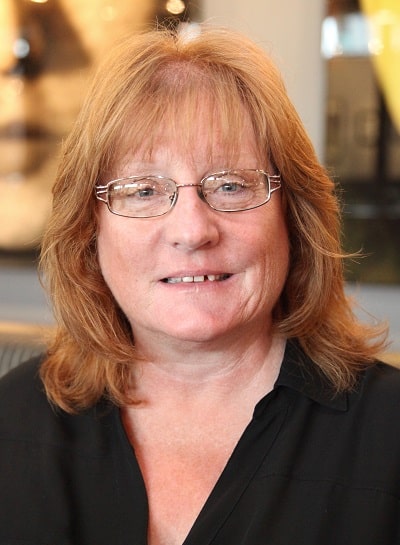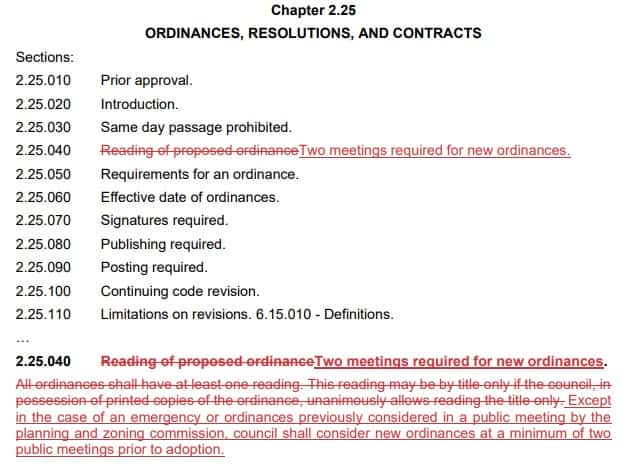
We would like to commend Sedona City Councilman Pete Furman and Councilwoman Kathy Kinsella for getting their ordinance on ordinances passed de facto unanimously at the July 11 meeting and thereby requiring new city laws to be read twice.
Unfortunately Furman, who had spearheaded the new policy, was excused from the meeting and was thus unable to vote on it, but it passed 6-0 and he most certainly would have been the seventh vote.
The change was relatively simple. Sedona City Code Section 2.25.040 currently reads, “All ordinances shall have at least one reading. This reading may be by title only if the council, in possession of printed copies of the ordinance, unanimously allows reading the title only.”

The new amendment changes that language to require “two readings.”

While seemingly inconsequential, in practice it will give residents at least one more meeting — and roughly two weeks of time depending on when council officially reads the ordinance aloud — to hear what the new law affecting the community will involve. This means that items that appear at one council meeting can’t be immediately made into city law by the end of that meeting.
That potential swiftness has always imperiled the public, who could be blindsided by a new ordinance conceived, crafted, debated and made into law during a single heated meeting. Residents have then had to spend time and effort organizing a referendum or convincing officials to repeal or modify an ordinance rather than letting cooler heads prevail and waiting for one more meeting so the public could weigh in. To prevent bad ideas from becoming bad laws, this pause lets residents contact council members directly or through the medium of Letters to the Editor in this publication, or motivate their neighbors to show up and speak against disastrous proposed laws.
It’s a win-win for both good laws and bad, as proponents of new and popular ordinances could have one more meeting to show up and voice their support.
The ordinance also states that a reading of a proposed ordinance by the Sedona Planning and Zoning Commission could count as one hearing under the new law. New ordinances could also become law in an “emergency,” but aside from the declared emergency during the COVID-19 pandemic or some pending state-imposed deadline or court order, there is almost no “emergency” that can be invoked to deny the public two readings.
The caveat is that previously, city council members could skip reading the whole ordinance aloud to the public and instead just read the title if council unanimously decides that’s enough for them.
Reading ordinances in their entirety is not for council’s benefit. It is for us, the public, the residents of Sedona. Council members have time to meet with the city attorney or city manager or department heads for hours to discuss new laws and their implications. We, the public, do not have this luxury, so ordinances should be read in their entirety for the public.
One argument against reading whole ordinances aloud is the length of the meetings, which is bit silly. A regular Sedona City Council meeting routinely lasts four or more hours, while a contentious one with controversial items can last six or more hours.
Compare that to the brisk one-hour meetings in Camp Verde, which has 2.32 times more land and 25.4% more residents. Cottonwood — which has 24.2% more people, a comparably-sized budget and far more city departments and city services Sedona lacks like a municipal fire department, a recreation center and a city-run library — has meetings that barely break an hour. Even this spring, when Cottonwood had its most contentious meetings in years, they still ended in less than three hours.
New ordinance or not, Sedona’s meetings could be shorter if council members were less verbose, or formulated questions before meetings rather than pontificating in stream-of-consciousness ramblings that lack actual questions, or if the mayor or vice mayor running the meetings kept debate limited and council members focused on the task at hand. Or, council could have more than one marathon meeting per fortnight, and instead, more shorter meetings.
Alternatively, council could make the reading of an ordinance a part of the meeting that residents would want to watch rather than just a bullet point on the agenda. Instead of having the city attorney read the ordinance from a table, council should go one step further and make the reading a full-on spectacle.
John Conway, or someone with his equally booming and commanding voice, could read the ordinance aloud dressed in 1770s colonial garb and powdered wig. Tom and Shondra Jepperson could read the ordinance in tandem dressed as T.C. and Sedona Schnebly. Residents or supporters who proposed, advocated for or shepherded an ordinance through the process could be recognized for their public spirit by being chosen to read the ordinance into the record.
Lawmaking is boring, but it doesn’t have to be.



















